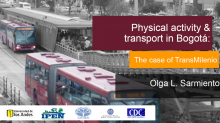We are pleased to announce an exciting new alliance between Active Living Research and GP RED to co-host and coordinate...
Physical Activity, Health and Transport in Bogotá: The Case of the Bus Rapid Transit System

Presentation at the 2013 Active Living Research Annual Conference.
Background and Purpose
Walking is a mode of transportation that could potentially replace short to medium distance trips, previously made in motor vehicles. in addition, walking for transportation can contribute to meet physical activity recommendations and reduce sedentary behaviors. in Latin American cities like Bogotá and Curitiba, previous studies have shown the potential of public transit access to promote walking for transportation. Bogotá the capital city of Colombia is internationally recognized for advancing sustainable Transport due to the construction of the Bus Rapid Transit (BRT) TransMilenio (TM). in the year 2000 TM brought to the users a reduction on the travel time, emissions of particulate matter and traffic accident rate. The implementation of BRT systems have increased worldwide but studies regarding the association between TM use and walking for transport are limited.
Objectives
To assess the association between the use of TM and walking for transport in adults from Bogotá.
Methods
This study is part of the International Physical Activity and the Environment Network (IPEN). The study population includes 1000 adults in 30 neighborhoods from 18 to 70 years of age. Physical activity was measured through the International Physical Activity Questionnaire (IPAQ) and accelerometers. Perception of the environment was measured through the Neighboorhood Environment Walkability Scale (NEWS). The association between walking for transport and use of TM was estimated using multilevel Poisson-models adjusting for sex, age, occupation, education, socioeconomic status, walkability index distance to TM and number of TM stations.
Results
Overall, 50.9% of the participants reported walking at least 150 minutes for transportation. Regular users of TM were more likely to walk at least 150 minutes for transport (57.6 vs. 48.1; <0,001). After adjusting for potential confounders, regular users of TM were more likely to meet the physical activity recommendation walking for transportation (PR=1.3, IC 95% (1.01-1.59), p=0.04).
Conclusions
This was the first study that examined the association between walkability and walking outcomes in a developing country with identical protocol, design and instruments employed high- income countries. The main findings emerging from this study showed that adults living in highly walkable areas are more likely to achieve recommended levels of PA through walking as mode of transport. Additionally, no significant interaction between neighborhood walkability and income was found, indicating that walkability is strongly associated with walking for commuting regardless of the participants’ neighborhood income. Finally, walkability was not associated with walking for leisure. These results extend the evidence by demonstrating that built environment is an important PA correlate in developing countries. This study confirms findings from high-income countries and showed that walkability is positively associated with PA of adults living in Latin America.
Support / Funding Source
This study is funded by a Fogarty grant supporting the International Physical Activity and Environment Network IPEN project and The National Institute of Science, Technology and Innovation – COLCIENCIAS.
- DOWNLOAD "2013_ActiveTravel_Sarmiento.pdf" PDF (2.64 MB) Presentations
STAY UP TO DATE
RECENTLY ADDED TOOLS & RESOURCES
MOVE! A BLOG ABOUT ACTIVE LIVING
The "Active Living Conference" aims to break down research and practice silos and...







